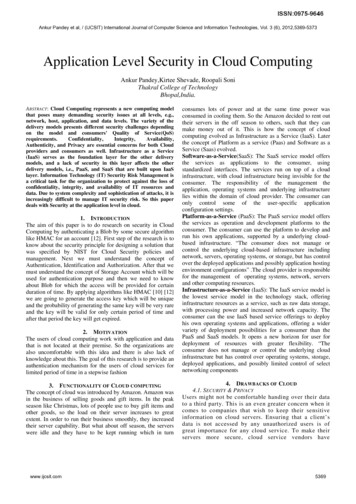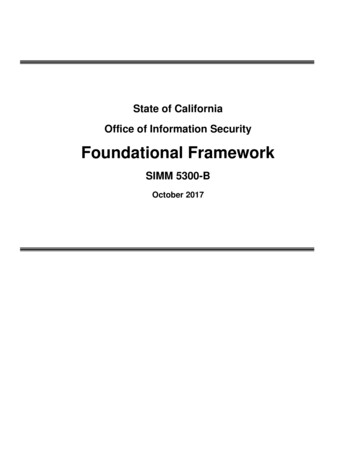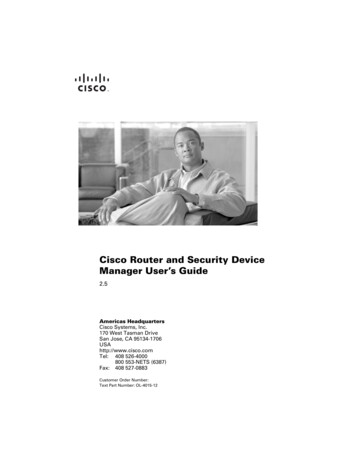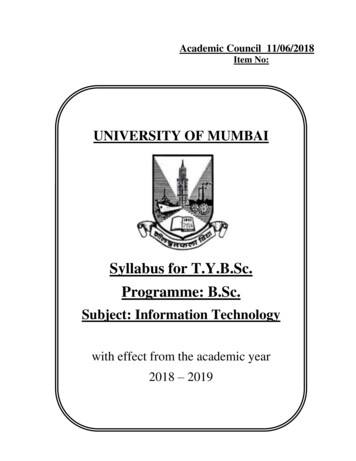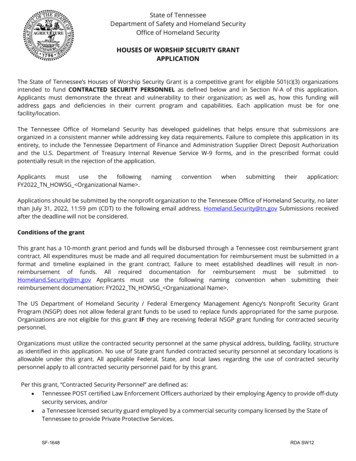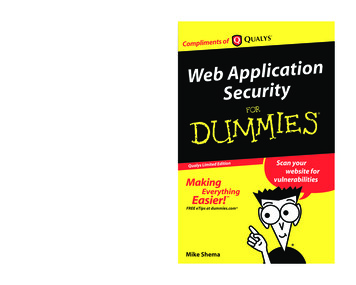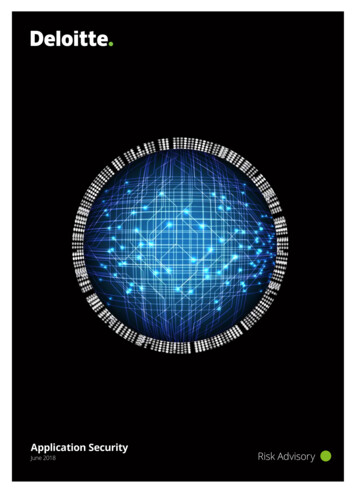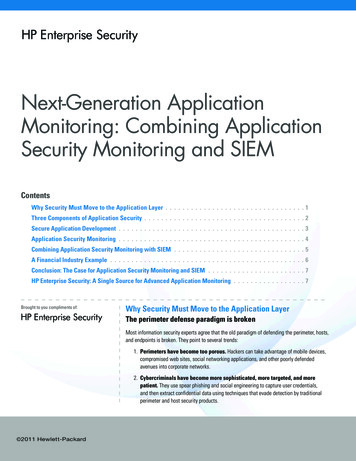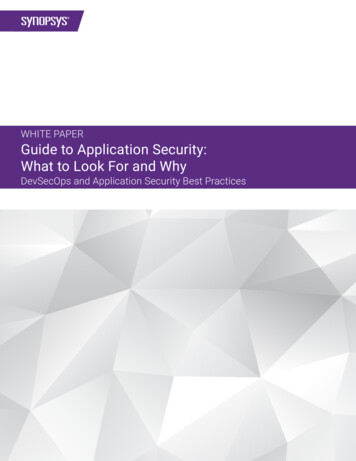
Transcription
WHITE PAPERGuide to Application Security:What to Look For and WhyDevSecOps and Application Security Best Practices
Table of contentsIntroduction.1Waterfall, agile, DevOps, and DevSecOps basics.1What is DevOps?. 1What is DevSecOps?. 1Enterprise development requirements.2Start security testing by shifting left.2Static versus dynamic testing. 2Shifting left eliminates unnecessary work later. 2What to look for in an application security tool.3Essential features. 3Integrations. 3Reporting. 3Team-specific needs. 3What to look for in an AppSec software-as-a-service (SaaS) platform.4Developers want ease of use, speed, and accuracy. 4DevOps leads need integrations for development environments, tools, and cloud platforms. 7CISOs focus on security vulnerabilities and policy compliance. 7Best-in-class AppSec tools and services.8 synopsys.com 2
IntroductionIf your organization does software development in-house, there are a myriad of development workflows and processes tochoose from. Some organizations still implement old-school waterfall development workflows; some are agile shops. In terms ofprocess, some have adopted DevOps, and some integrate security testing into DevOps workflows for DevSecOps.How and why should you transition from one approach to another? What do you need to change in terms of culture, tools,techniques, and processes? What tools and processes can help you integrate application security into your DevOps workflowsand enable seamless testing for developers in your organization? Which tools and processes work in which stages of thesoftware development life cycle (SDLC)? Should you be thinking about containerization? Should you develop code in the cloud?How do you get started? If you’re a CISO, how does DevSecOps improve software security and generate tangible savings in leadtimes to prevent a major exploit? How should you evaluate and select application security tools, and how should you partner withyour development teams?This white paper answers some of these questions and describes best practices for securely accelerating your software velocity.Waterfall, agile, DevOps, and DevSecOps basicsMany organizations have moved away from the rigid sequential stages of waterfall toward agile development. Agile developmentgives organizations the flexibility to make changes in any phase, support frequent requirement changes, and perform testingconcurrently with software development.What is DevOps?DevOps is an ideology that combines cultural philosophies, technical practices, and tools to help development and IT operationsteams work collaboratively to build, test, and release software faster and more reliably.According to The DevOps Handbook, “In the DevOps ideal, developers receive fast, constant feedback on their work, whichenables them to quickly and independently implement, integrate, and validate their code, and have the code deployed into theproduction environment.”1What is DevSecOps?DevSecOps involves integrating security testing into continuous integration (CI) / continuous delivery (CD) workflows. CI/CD isfacilitated by automated software development workflows and processes (e.g., in the build, test, and release phases).Continuous integration (CI) is a software development practice where team members integrate their work frequently. Typically,each person integrates daily, leading to multiple integrations per day. Integrations are verified by an automated build (includingtest) to detect integration errors as quickly as possible. CI build servers automatically pull in requisite files and dependenciesfrom SCM repositories when developers check their updates into the version control system.Continuous delivery (CD) is a software development discipline where software is built in such a way that it can be released toproduction at any time. Continuous deployment (also CD) means that every change goes through the pipeline and automaticallygets put into production, resulting in many production deployments every day. Build servers are also used to enable continuousdeployment, deploying updates to production when a build succeeds and passes all tests. Following stringent CI/CD workflowsis becoming the norm in modern enterprises that develop and deploy software. synopsys.com 1
Enterprise development requirementsDevelopers need to be able to write, debug, and test code quickly and easily, before checking it into a central build. They needaccess to industry-standard integrated development environments (IDEs) that support their style of code development and codeintegration. Many DevOps tools integrate into the IDE to ensure developers can use them without any friction.Logically, this trend should also apply to application security testing and AppSec tools. Tools that can integrate into the IDEare preferred by developers, who can then maintain security compliance while they work in their native environments. Bettersecurity compliance from developers helps security executives improve operational efficiencies and accelerate release velocities.Improved efficiencies and faster release velocities, in turn, translate into a significant reduction in the total cost of ownership ofthe application security solution.Zooming out, we see emerging technologies in container development slowly becoming mainstream. Development teams areadopting container orchestration systems, such as Kubernetes, to automate container and binary cluster deployments and tocontrol and manage the scaling of containerized applications. Large enterprises are moving development to the cloud to offloadcosts and save resources while benefiting from a faster time to market and the scalability advantages of not having to purchaseand maintain servers.At the end of the day, it’s all about increasing software velocity to meet rapidly changing business needs. To do this,organizations need to empower their developers by giving them tools and establishing workflows that make delivering secure,high-quality software faster and more efficient.Start security testing by shifting leftMany studies have shown that it’s faster, easier, and cheaper to find and fix software issues early in the development process,as developers write code, rather than later (e.g., in testing, QA, or production). Organizations often use application security tools,such as static application security testing (SAST) tools, early in development to find and fix both quality issues and securityvulnerabilities. Teams often use SAST tools in conjunction with software composition analysis (SCA) tools, which find securityvulnerabilities and license issues in open source components.Static versus dynamic testingMany organizations use dynamic application security testing (DAST) or penetration testing during QA or just before production.DAST and pen testing dynamically test an application for security vulnerabilities that can’t be detected using SAST or SCA tools.Security teams often perform DAST and pen testing periodically on live released applications for security compliance reasons.But running dynamic testing on live applications exposes them to cyber attacks and potential data breaches.In addition, while DAST and pen testing can identify security vulnerabilities, they can’t identify the corresponding lines of codecontaining the vulnerability—something that SAST tools can do before an application is in production to reduce the attacksurface for a potential vulnerability. As a result, critical security issues identified by DAST can be problematic to fix and can take along time to resolve. With companies now deploying to production multiple times a day (e.g., Netflix), a live security vulnerabilitylurking in production code can spell disaster, affecting the bottom line instantly. This potential for far-reaching, immediate impactfrom a single vulnerability is why SAST sees more widespread adoption than DAST.Shifting left eliminates unnecessary work laterInstead of sifting through and prioritizing long lists of security issues (including false positives) generated by “noisy” DAST toolspost-release, security teams should instead work closely with their development teams to eliminate vulnerabilities earlier inthe SDLC by using SAST, SCA, and interactive application security testing (IAST) tools. IAST tools dynamically test applicationsduring runtime, typically in the test and QA phases, to identify security vulnerabilities that SAST or SCA tools couldn’t find. UnlikeDAST tools, which have slower analysis times, IAST tools can integrate seamlessly with build and test automation tools (e.g.,Selenium) and quickly generate analysis results that identify specific lines of code where security vulnerabilities reside. As aresult, developers can fix identified issues quickly and push their commits to run automated CI/CD workflows. synopsys.com 2
What to look for in an application security toolEssential featuresApplication security (AppSec) tools must have certain basic features to be effective: They must be fast, accurate, and comprehensive. They must be easy to use and easy to deploy, with support for multiple languages and frameworks. They must have powerful automated analysis engines that don’t just scratch the surface but dive in deeper to findcritical quality and security vulnerabilities that are difficult or impossible to discover through manual code review orpenetration testing. They must provide support, plugins, and integrations for various tools in the SDLC: industry-standard IDEs, source code andOSS repositories, CI build servers, bug trackers for triaging identified issues, and cloud and container development tools.IntegrationsWith the need to stay competitive and achieve a faster go-to-market, organizations are focusing on low-overhead applicationsecurity testing, which is driving the push to go to cloud. Therefore, application security testing tools must seamlessly integratewith development and DevOps tools used either on-premises or in the cloud. AppSec tools must fit with the tools that developersand DevOps leads are already using or will use in the future. If these tools slow down development, neither development norDevOps teams will adopt them.ReportingAppSec tools must also provide comprehensive and extensible reporting schemes. These should cover not only the tacticalaspects for triaging and remediation by security teams but also executive-level dashboards and reports for heads ofdevelopment and security. For example, they must provide security trend data and compliance information in relation to industrytaxonomies (e.g., OWASP Top 10, CWE/SANS Top 25). AppSec tools must be adaptable to organizations’ needs and help themreduce compliance overhead. Financial services organizations, for example, need reports in PCI formats, whereas the medicalindustry relies on compliance reporting with HIPAA.Team-specific needsSecurity leads strive for continuous visibility into the most critical vulnerabilities that could adversely affect their organizations.Development leads, on the other hand, rely on AppSec tools to provide (1) detailed contextual remediation guidance foridentified issues and (2) real-time security training so developers don’t need to be security experts to fix vulnerabilities and checkin cleaner code. synopsys.com 3
What to look for in an AppSec software-as-a-service (SaaS) platformEach role in an organization looks for certain factors when evaluating a new platform:Development leads look for tools that fit seamlessly into their existing workflows, that are accurate, and that don’t generate a lotof false positives. They want to avoid tool-related developer frustration and wasted time.DevOps leads look for tools that integrate with their existing build systems and development and test tools and processes.CISOs, allied executives, and security leads look for robust, comprehensive reporting capabilities that accurately prioritize criticalsecurity vulnerabilities for remediation. They look for time-saving automated tools that can generate executive-level reports thathelp them maintain compliance with regulatory and security standards.Synopsys’ Polaris Software Integrity Platform is a scalable solution that can address many requirements for each of these rolesout of the box.Figure 1. Synopsys Software Integrity PlatformCode SightCentral ServerDeveloper EnvironmentBuild & Test EnvironmentIDE PluginIntelliJ, Eclipse, Visual StudioIntegrated Local Central AnalysisDevelopersCoveritySASTBlack Alerting &WorkflowCISOsIntegrated Analysis EnginesCoverityBlack DuckSeekerSASTSCAIASTCI/CD & DevOpsIntegrationManagedServicesSaaS/Private CloudDeploymentDevOpsLeadsDevelopers want ease of use, speed, and accuracyDevelopers need AppSec tools that help them do their job without getting in their way or creating extra work. Developers typicallyuse SAST IDE plugins to identify and fix issues before checking in their code for central build analysis. However, many SAST IDEplugins are “lightweight” and can find only a subset of vulnerabilities. Using them can cause builds to break because of securitycompliance or quality gates.With Synopsys’ Code Sight IDE plugin for the Polaris platform, developers don’t have to sacrifice accuracy for speed. Code Sightis a productivity tool that helps developers identify and triage software defects early in the SDLC, so they don’t propagate thesame errors further downstream, where it’s much more expensive and time-consuming to remediate.Fast incremental analysisWith Code Sight, developers can get Coverity SAST incremental analysis results in seconds within their IDE. Code Sight doesincremental analysis automatically in the background every time developers open or save a file. For consistent, accurate results,the plugin uses the same Coverity analysis engine used for full baseline central analysis. And Polaris automatically synchronizesincremental analysis results with central analysis scans, so developers can focus on coding without having to invoke scansmanually or interrupt their workflow. synopsys.com 4
Security training and remediation adviceDevelopers using Code Sight get “in-the-moment” security training and remediation advice on how to fix issues as they arecoding, without leaving their IDE. Remediation advice includes detailed issue descriptions, prioritized vulnerabilities by severity,links to CWE information, and dataflows that help them debug their issues and prevent security and quality issues from enteringthe main codebase.Code Sight also provides developers with links to eLearning courses related to the CWEs associated with specific issuesin their code. When developers receive contextual security training, they don’t have to be security experts to fix newvulnerabilities as they arise.Consistent user experienceCode Sight’s modern developer interface is consistent across standard industry IDEs (e.g., Visual Studio, Eclipse, IntelliJ) and allSynopsys products supported on the Polaris platform. Consequently, developers don’t have to learn a new UI each time they usea new security tool.Figure 2. Code Sight screenshot examples (in IntelliJ)Prioritized vulnsby categoryCrisp issues viewRemediation advice synopsys.com 5
Related eLearningcoursesDataflow view: main& supporting events synopsys.com 6
Open source managementAccording to the Synopsys 2019 OSSRA report, the majority of codebases (96%) reviewed by the Black Duck Audit Services teamin 2018 contained some open source code.2 More than 60% of the codebases contained known vulnerabilities, and 68% hadlicense conflicts.3 Policy violations can occur with security policies, technical/operational policies, or legal compliance policiesthat cite restricted legal licenses.With tools such as Black Duck SCA, developers can get information on the risks associated with their use of open sourcecomponents—including security vulnerabilities and license policy violations—early in the development process. Black DuckRadar, a native Chrome browser plugin, shifts analysis even further left, as it can identify free and open source software (FOSS)components with known issues based on version numbers before developers download them for use.Figure 3. How Synopsys products fit into the SDLCBlack Duck RadarPre-CommitCommitBuildTestDeployProductionFOSS repositoriesCode Sightin IDE withCoverity SAST(SCM repositories)Coverity SAST central analysisSeekerManaged Services DAST and penetration testingBlack Duck SCABlack DuckBinaryAnalysisCross-correlation of results between toolsUsing the analysis results from one tool to improve the results from another leverages the strengths of each tool and savesdevelopers time. The Polaris platform will soon support cross-correlation between Coverity SAST and Black Duck SCA.Developers can use Coverity to determine which open source vulnerabilities it identifies are reachable in the code and to helpprioritize issues for remediation. They can use Black Duck to filter these Coverity-identified issues to those found in open sourcecomponents to be triaged and mitigated using Black Duck. They can then use Coverity to focus on issues related to proprietarycode in the same application. synopsys.com 7
DevOps leads need integrations for development environments, tools, and cloudplatformsDevOps leads don’t want to have to write scripts to get new AppSec tools to work in their CI/CD workflows. Instead, they wanttools that are ready to integrate with their CI build servers, container orchestration and cloud platforms, and repositories. WithPolaris, Synopsys SIG products (e.g., Coverity, Black Duck, Seeker) work with a myriad of developer tools, including Code Sight formarket-leading IDEs, as seen in Figure 4 below.Figure 4. Polaris platform supportScalabilityWith Polaris, it’s possible to quickly onboard and analyze thousands of applications and support tens of thousands of developers.The platform’s support of industry-standard cloud platforms on the Kubernetes orchestration engine enables accurate andcomprehensive security scanning that elastically scales with your business requirements.CISOs focus on security vulnerabilities and policy complianceCISOs and security leads need to be able to understand and manage their organizations’ security risk posture across theirapplication portfolio at any time. They need to be able to identify, prioritize, and resolve the most critical security vulnerabilitiesthat threaten their organizations. Polaris combines best-in-class security tools with robust executive security reportingdashboards to provide cross-product aggregated reporting. The platform also cross-correlates analysis results to ensure reportsare highly accurate and comprehensive. synopsys.com 8
Figure 5. Polaris cross-product aggregated reporting view of Coverity SAST, Black Duck SCA, and Seeker IAST analysis resultsIssues by Categories(OWASP 2017)Figure 5 shows the Polaris reporting option to download either individual analysis reports or an aggregate report of analysisresults for a project. For the project shown, analyses from Coverity SAST, Black Duck SCA, and Seeker IAST are available.Polaris also provides reporting dashboards of industry-recognized security standards (e.g., OWASP Top 10, CWE/SANS Top25). Users can create priority lists (e.g., top issues by technical risk indicators, as shown in Figure 6) so they can focus onthe issues that matter most to the organization. Predefined filters allow users to filter and group issues by CWE, standardstaxonomy, priority list, risk indicator, path, and individual developer owners for quick remediation. Polaris provides central policymanagement features, an aggregated risk profile of issues, trend information for categories and issues over time, and the abilityto generate PDF reports for audit and management reporting.Figure 6. Polaris Technical Risk Indicators view synopsys.com 9
Best-in-class AppSec tools and servicesSynopsys application security solutions have been recognized as industry leaders in industry analyst reports, such as the GartnerMagic Quadrant for Application Security Testing, The Forrester Wave : Static Application Security Testing, Q4 2017, and TheForrester Wave : Software Composition Analysis, Q2 2019. Our products and services help development and security teamsbuild secure, high-quality software faster.Coverity SAST. Coverity helps developers find and fix security defects early in the SDLC, with support for 20 languages and over70 frameworks and template engines, as well as security checkers to help ensure compliance with OWASP Top 10, CWE/SANSTop 25, PCI DSS, and other standards. Coverity gives teams the flexibility to analyze code in the IDE and on the build server, onpremises and in the cloud.Black Duck SCA. Black Duck enables teams to secure and manage open source across their software supply chain. Black Duck’sunique multifactor open source discovery technology accurately detects open source in source code, binaries, and containerimages, giving development, security, and legal teams complete visibility into their open source security and license compliancerisks. In addition, integrated policy management allows teams to automate open source governance, so they can build fast whilestaying secure and compliant.Seeker IAST. Seeker helps development, QA, and security teams automate application security testing with CI and testautomation tools. Seeker is the only IAST solution that actively verifies that identified vulnerabilities are exploitable, usingpatented technology, reducing false positives to near zero. Its unique sensitive-data tracking feature automatically detects whenuser-designated sensitive data is exposed in logs, databases, or files.Managed Security Testing. Synopsys Managed Security Testing Services deliver on-demand security testing performed by ateam of security experts, helping organizations cost-effectively address complex test scenarios. Synopsys’ Managed PenetrationTesting combines testing tools and in-depth manual tests focusing on business logic to find vulnerabilities outside commonstandards, including authentication checks, access control testing, logging and monitoring, workflow bypass, and manual reviewto identify false positives.Polaris Software Integrity Platform. Polaris brings Synopsys’ tools together to provide a comprehensive, automated applicationsecurity solution that enables teams to build secure software faster. The Code Sight IDE plugin integrates security analysisinto the developer’s desktop, while the Polaris central server gives security and development teams a single-pane-of-glass viewof project vulnerability trends and helps them manage compliance with the security standards and regulations that are mostimportant to their organization.About the authorsUtsav Sanghani, Senior Product Manager, Software Integrity Group, SynopsysUtsav has spent a good part of the last decade with various enterprise software products, including productivity tools, softwarecomposition analysis, and static analysis. He drives thought leadership, strategic initiatives, and tangible solutions with a specificfocus on making developers and DevOps solutions compatible with application security.Anna Chiang, Senior Product Marketing Manager, Software Integrity Group, SynopsysAnna is a Certified Information Systems Security Professional who has worked in product marketing for SAST, IAST, andUEBA security products, platform product management, and developer programs management for enterprise and mobileapplication solutions.References1. Gene Kim, Jez Humble, John Willis, and Patrick Debois, The DevOps Handbook, IT Revolution, 2016.2. Synopsys, 2019 Open Source Security and Risk Analysis, 2019.3. Ibid. synopsys.com 10
The Synopsys differenceSynopsys helps development teams build secure, high-quality software, minimizing risks whilemaximizing speed and productivity. Synopsys, a recognized leader in application security,provides static analysis, software composition analysis, and dynamic analysis solutions thatenable teams to quickly find and fix vulnerabilities and defects in proprietary code, open sourcecomponents, and application behavior. With a combination of industry-leading tools, services,and expertise, only Synopsys helps organizations optimize security and quality in DevSecOpsand throughout the software development life cycle.For more information, go to www.synopsys.com/software.Synopsys, Inc.185 Berry Street, Suite 6500San Francisco, CA 94107 USAContact us:U.S. Sales: 800.873.8193International Sales: 1 415.321.5237Email: sig-info@synopsys.com 2020 Synopsys, Inc. All rights reserved. Synopsys is a trademark of Synopsys, Inc. in the United States and other countries. A list of Synopsys trademarks is available atwww.synopsys.com/copyright.html . All other names mentioned herein are trademarks or registered trademarks of their respective owners. February 2020 synopsys.com 11
critical quality and security vulnerabilities that are difficult or impossible to discover through manual code review or . OWASP Top 10, CWE/SANS Top 25). AppSec tools must be adaptable to organizations' needs and help them reduce compliance overhead. Financial services organizations, for example, need reports in PCI formats, whereas the .
